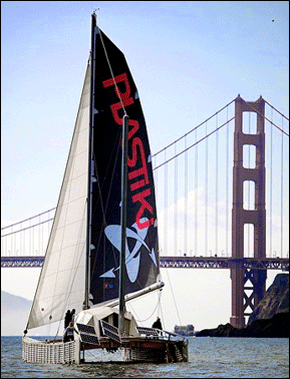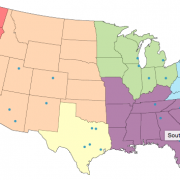Eco-Explorer David de Rothschild Begins Trans-Pacific Journey on Catamaran of Plastic — the Plastiki
The voyage and vessel are designed to redefine global use, and reuse, of plastic.

UPDATE: The Plastiki crew has almost reached the equator and Kiribati Atoll (Christmas Island) in the Line Islands since it set sail last month, according to a press release from the team. As De Rothschild and the rest of his team document their journey through film, Twitter and blog posts they are also focused on maintaining the ship’s unique structure as they head towards Sydney, Australia.
As the crew notices the presence of more wildlife, they also say that “the amount of plastic pollution is still very noteworthy.”
De Rothschild and his crew of five started their mission March 20 on perhaps the first-ever crossing of the Pacific Ocean that’s being measured in plastic bottle lengths.
The Plastiki is comprised of a 60-foot catamaran with a hull made of 12,500 plastic bottles, which roughly equals the length of 481,536 plastic bottles.
And those hundreds of thousands of bottles are only .0080 percent of the bottles thrown away by Americans today, according to The Plastiki Expedition Web site.
The entire project aims to focus global awareness on the thoughtless, unnecessary damage plastic inflicts on the world’s oceans. And potentially guide people towards more constructive ways to re-use plastic.
“What I hope that the Plastiki does and what we stand for is not about vilifying people, pointing fingers or just articulating problems,” de Rothschild told Circle of Blue in October. “We are about challenging that thinking.”
During the next 90 days the crew, directed by skipper Jo Royle, will travel about 11,000 nautical miles from San Francisco, California to Sydney, Australia. The so-called Great Pacific Garbage patch is a focal point of the expedition. Ocean currents from North American and Asian shores sweep along floating plastic, funneling it towards the island of trash, which is already larger France and Germany combined.
It’s a vivid illustration of the roughly 50 percent of all plastic products that end up in the ocean. The patch also has serious implications for pollution. Project Kaisel at the Scripps Institution of Oceanography is testing the patch for toxins like Polychlorinated Byphenyls (PCB) and DDT that have serious health impacts if they’re absorbed into fish consumed by people.

This expedition is as much about demonstrating the responsible reuse of plastic as drawing attention to its problems.
“The first reaction that any environmentalist would go for is ‘plastic is the enemy –ban it,’” de Rothschild told Circle of Blue. “Let’s just think for a second and really evaluate — is it the material [that’s bad] or is it our inability to understand how we use it, how we manufacture it, what are we using it for, and most importantly, how we dispose of it.”
De Rothschild has made a career of exploring ecological challenges, and using his wealth to popularize environmental issues. The youngest heir to the fortune of one of Europe’s oldest and most respected banking families, he journeyed across Antarctica and explored the Greenland ice cap to witness the consequences of climate change firsthand. In 2005 he launched Adventure Ecology, an organization and a Web site that tracks his travels to inspire people to work for positive change for the planet.
His Pacific plastic bottle mission is a way of reconnecting life style choices to nature, an idea that has become his mantra.
Follow the Plastiki’s progress at the Plastiki Expedition Web site. To read more about the de Rothschild expedition, please see Circle of Blue’s earlier de Rothschild coverage.
Sources: Plastiki Control Center, SFGate.com
is a Washington, D.C–based correspondent for Circle of Blue. He graduated from DePauw University as a Media Fellow with a B.A. in Conflict Studies. He co-writes The Stream, a daily summary of global water news.





Audit the fed, support HR 1207